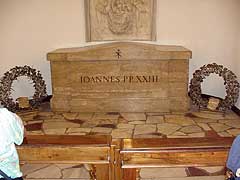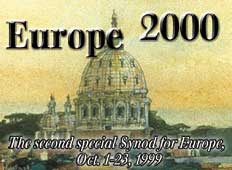European Synod
II
Pope John XXIII - an essay
By THOMAS C. FOX
With several hundred Italian pilgrims singing loudly under the dome
of St. Peter’s Basilica where they celebrated mass at the high
altar, John Allen, my wife, Hoa, and I slipped quietly down some
circular marble steps a few feet away to visit the papal crypts.
I find peace and perspective here. Not far from the steps is the
crypt of Pope John XXIII. Memories and the ageless marble invite
prayer. Failing official proclamation, John XXIII fits the bill as
NCR patron saint. It was out of his vision, hope and council
that NCR was born in 1964.

The crypt of Pope John XXIII
photo by -- Tom Fox
It was on Oct. 11, 1962, thirty-seven years ago this month, John
XXIII opened the Second Vatican Council, his gift to the church. He
spoke that day and told us not to fear. He told us to have faith and
to dispel the “prophets of gloom.” He meant, of course,
those members of the Roman curia whom he saw as having a stranglehold
on the church.
He was open and wanted a church engaged with the modern world. He
saw the Holy Spirit active in the world. It was to be our task to find
Her by understanding the “signs of the times.”
How seemingly different is the mood among the hierarchy in Rome
today. If images speak, then in place of the smiling John XXIII, we
see a pained John Paul II, his face grimaced, his tired body leaning
on his crosier, carrying the world’s burdens on his shoulders.
Pope John gave us Pacem in Terris, a map to worldwide human
understanding. Pope John Paul II gives us an analysis of the “culture
of death,” an acknowledgment of global human failure.
This is not to say John did not understand the cross or John Paul
the resurrection. It is to say their views of how grace operates in
the world are radically different. John saw the church as an
instrument of cooperative acts. John Paul sees the church as a
fortress tested by evil. John saw the world, the playground of God’s
love, as primary. John Paul sees the church, instrument of salvation,
as primary. Operating out of John’s vision, the church not only
can but also must adapt. It changes because the world changes.
Operating out of John Paul’s vision, the church must strengthen
itself by purification. It must not adapt because to do so is to blur
the sign of contradiction.
The pain Catholicism has endured this past quarter century has
resulted in large measure from being conflicted by these seemingly
irreconcilable ecclesiologies.
At the synod’s first press conference Oct. 2 journalists asked
a handful of synod bishops, including Cardinal Antonio Maria Rouco
Varela, archbishop of Madrid, the synod general relator, what
the synod fathers had new to offer the people of Europe. The question
was significant because Rouco Varela’s opening relatio,
or reflection, was viewed as quite pessimistic. His remarks mirrored
those found in the synod’s Instrumentum Laboris, the
synod’s official working document. It spoke of European apostasy.
Entirely gone this time was the hope expressed at the first European
synod, in 1991, held just months after communist regimes were swept
off the European map. In 1991, John Paul looked out across Europe at
his native Poland and saw infinite possibilities, new hope for an
unshackled church coming to full life. By contrast today, he is deeply
troubled, seeing his fellow Poles lost in misused freedom.
As if to reflect this view, one British journalist claimed a word
search found the most frequent noun in Rouco Varela’s opening
remarks to be “despair.”
Given such utter failure, such inability to convincingly preach the
promise and path of salvation, then what radical change might the
church fathers consider? It seemed a reasonable question.
The late NCR Vatican Affairs Writer Peter Hebblethewaite
once said the deeper underlying problem with John Paul’s black
and white assessment is not that the world is so black but it makes
the church so white. So unrepentive. So resisting of change. The
perfect instrument of God requires no change. Further, it must not
change.
Off the ecclesial roadmap, then, are reasonable correctives that
could fundamentally alter the course of Catholic history overnight.
Clericalism could end with a married priesthood. Sacramental life
could be enriched by inviting the divorced and remarried back to the
Eucharist. Women could be rightfully recognized as complete images of
the divine by encouraging an open theological discussion on the women’s
ordination. Theologians could again reflect upon the lived experiences
of Catholic couples who could finally emerge from bifurcated lives
torn between official church teaching and marital love. Church
teachings on human sexuality could finally become relation-based.
Similarly, gays and lesbians could more readily recognize God’s
hand in their lives. Catholic scientists could freely enter into
pressing examinations of complex questions, seeking deeper answers in
the expanding field of bioethics.
So is the turn-of-the-millennium crisis to be placed entirely at the
feet of an “apostate” people?
Or is Roman Catholicism increasingly irrelevant to a younger
generation of honest and intelligent, spiritually and ethically-
motivated, men and women?
The Pope John figures who sit among the bishops at this synod have
learned they must temper, even hide, their thoughts and remarks.
Conversation, the sharing of ideas as normally understood, is not
encouraged by the synod format in which bishops speak, one at a time,
without theme and without debate. In the perfect church there is not
debate because there is only one “truth” and it is
proclaimed by only one man for all time. One only has to learn the
catechetical response.
Some might say the John figures no longer exist among the assembled
bishops of Europe. This would be an incorrect assessment. Like so many
others, they, too, have learned to bite their tongues and wait for
another day.
Thomas C. Fox is NCR publisher.
National Catholic Reporter, October 7, 1999
|



